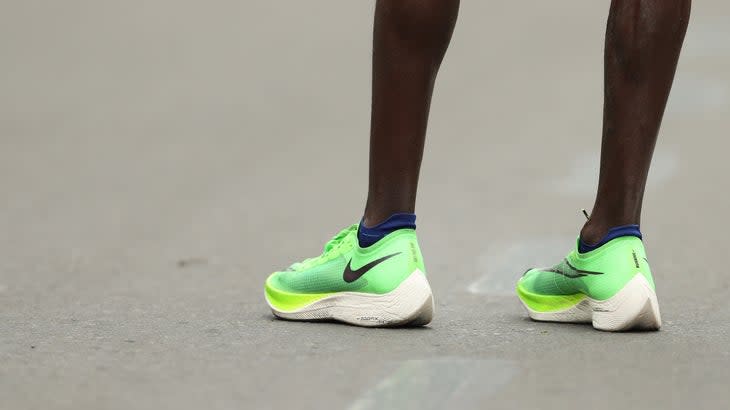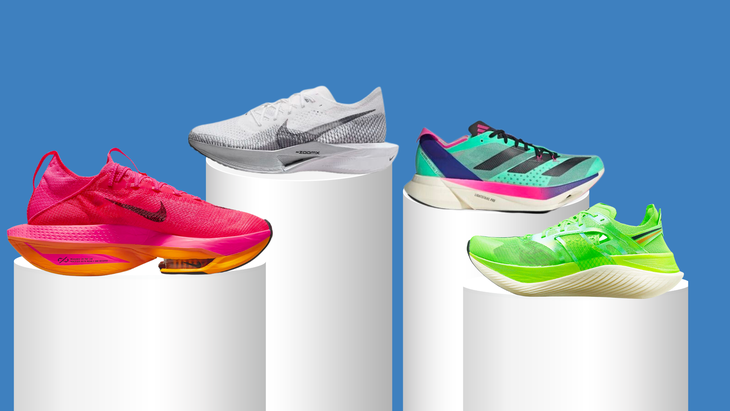9 Rules for Training in Super Shoes
- Oops!Something went wrong.Please try again later.
- Oops!Something went wrong.Please try again later.
This article originally appeared on Outside
Super shoes--models with curved carbon-fiber plates embedded in tall stacks of lightweight, hyper-responsive foams--are now ubiquitous in the road racing scene. And with their performance benefits well established, more and more recreational racers are giving them a try--not just in racing, but in training.
There's just one problem: the shoes have only been around for a few years, and while there is no doubt that they can make people faster in racing, there is little information on how to use them properly in training.
Two-time Olympian turned podcaster and NBC commentator Kara Goucher says it's a topic she's discussed with many people she knows. "How often do we use them? How often do we not?" are common questions Goucher says she hears. "We need to be careful, but we also do need to use them in practice because we want to get [the] advantages--but we don't want to get hurt...It's so complicated."
Finding answers begins by understanding how the shoes actually work.
How Your Body Reacts to Training in Super Shoes
For reasons that are not fully understood by biomechanics researchers, super shoes have a combination of foam and plate that make them function as springs, says Jay Dicharry, a Bend, Oregon, physical therapist, running gait expert, and author of Run Like an Athlete. "You're basically making a trampoline."
This has a number of effects. One is that your brain automatically reacts to the softer impact by reducing the amount of knee flexion upon landing, says Simon Bartold, a sports podiatrist and biomechanist in Adelaide, South Australia. The leg becomes stiffer because the shoe is absorbing the impact. It's part of why they are less tiring to run in.
Another big change, says Dicharry, is that the thick, cushiony foam increases the amount of time you spend in contact with the ground, as the foam contracts, then rebounds. That changes not only impact forces, but also cadence, the location of foot plant for the next stride, and a host of other factors. "Everything's different," he says.
These changes make the shoes fast, but they don't come without side effects, especially when the shoes are used in training. When the shoes first came out, Dicharry says he was working with elite-level athletes who were trying to figure out how to use them in training, "and every single one got hurt."
More recently, a paper by a group of physicians in Sports Medicine reported a possible association between training in super shoes and navicular (mid-foot) stress fractures. Bartold’s podiatrist and runner friend says he's been seeing an uptick in hip and lower back injuries since people started training in super shoes. The reason, Bartold suspects, is that the stiffer landing on impact allows what shock isn't absorbed by the shoe to travel up the leg, affecting you anywhere from the knee to the lower back. All told, Bartold says it's important to remember that these shoes weren't designed as trainers. "They were designed as a racing shoe," he says.

Principles for Training in Super Shoes
Given the benefits of super shoes, many athletes are going to wear them, even with their associated risks. "The results from using super shoes are undeniable," says Greg McMillan, exercise physiologist and founder and head coach of McMillan Running. "Has any record not been broken since the shoes came out? All performance-oriented runners should try them."
The question, then, is how best to use them. "The shoes are a tool, like anything else," says Dathan Ritzenhein, head coach of On Athletics Club in Boulder, Colorado.
While a lot of this is being invented in real time by coaches working mostly by trial and error, a few basic principles do seem to be emerging.
1. Allow your body to adapt to the new mechanics.
If you are new to super shoes, the first step is simple. You need to allow some time to get used to them, before you wear them in a race. "It's important to try them in practice to make sure there are no problems," Ritzenhein says.
That doesn't mean taking them out for a 20-mile training run right out of the box. Use them for part of a run, then take the time to stop and change shoes. How much of the run you use them for is an open question, but if you're using them in a speed workout, Dicharry suggests you might want to start with as little as five minutes. "Do slow, progressive changes," he says. "You need to be careful, because it's very, very different." And, he adds, don't even start the process if you have an ongoing acute problem, like a knee or Achilles tendon injury.
2. Most people shouldn’t run in them everyday.
"I ask my athletes to wear them only in more important and pivotal workouts," says Paul Greer, coach of the San Diego Track Club. For him, that mostly includes time trials or marathon pace runs, when you want to wear the shoes you plan to race in.
Mike Caldwell, coach of Greenville Track Club-Elite does something similar. "Our athletes use super shoes for both faster training sessions and competition," he says, noting that these usually add up to 12-15 miles of running per week for elites doing 85-90 miles total--roughly 15 percent of their training.
McMillan, on the other hand, knows some runners enjoy using super shoes for every run, and thinks that's fine for those who can afford it, have built up their super shoe mileage slowly, and haven't experienced any problems. However, the people who seem to be able to get away with this, he says, are the ones whose muscles and mechanics are unusually strong to begin with.
3. When you’re not using super shoes, run in more flexible shoes.
"Easy running in a less cushioned and more flexible shoe is a good counter to long training sessions in super shoes," Ritzenhein says. Greer adds that if, like his group, you only use super shoes for key workouts and races, you need to accept that your pace will be slower and possibly more tiring when using more conventional shoes. Don't let that get in your head, and don't try to fight it by turning workouts into races. That's a formula for overtraining.
4. Don’t use super shoes to cram in more hard workouts into your calendar.
Yes, there are indications that some pros may be taking advantage of the faster recovery you get from the shoes to do just this, but for most people--and many elites--it’s simply not worth the risk. "We don't try to increase the frequency of workouts," Ritzenhein says. "I feel the same principles apply to when the body is inflamed after workouts, so we try to not make the training week too dense and instead focus on the next quality session at the right time for recovery."
5. Use super shoes to do more intense workouts.
Greer does this by having athletes run time trials and marathon-pace runs in their shoes. Ritzenhein takes advantage of the lower impact of super shoes to increase volume in key workouts, such as long threshold runs. In both cases, it's increased intensity, but not increased frequency.

6. Avoid the temptation to add excess volume to your overall week.
"Because you do have so much foam on your foot, people feel as if they can go longer and harder," Bartold says. "Then you've got an increase in training volume which is potentially an issue for overuse injury." Yes, Kelvin Kiptum, current world record holder in the marathon, runs up to 300 kilometers a week (186 miles). But even his coach is afraid he might burn out if he keeps that up.
7. Be aware that not everybody will get the same benefit from any given shoe.
"Experimentation is the only way to know," McMillan says. In general, he says, runners who are "pushers"--meaning they are forward-balanced runners often with midfoot strikes and strong hip extension behind their torsos--get more benefit than "pullers"--the more shuffler, heel-striking type of runner. "This is why one runner may love super shoes and the training partner doesn't." It may also be necessary, he says, to take the time (and expense) of experimenting with different brands of shoes, because each super shoe is tuned differently, and what works for one person may not for another.
8. Don’t ignore the need for supplemental training.
"Feet can get weaker if you use [the shoes] a lot," Ritzenhein says. "Spending time on foot and lower leg strengthening is important." Exactly what such training you do is up to you. It could include something as simple as taking your shoes off once a day to free your feet, or more complex exercises like doing "alphabets" in which you attempt to write the alphabet in the air with your big toe. It might be doing barefoot strides on the turf after track workouts. Other options are calf raises, single-leg balancing exercises, or knee-strengthening exercises like wall squats, hamstring curls on a ball, or single-leg hamstring bridges. The bottom line is to be inventive and pay attention to your body. "If you want to run in super shoes, you need to put in the work to show up with stable parts," Dicharry says.
9. Listen closely to your body when recovering from races wearing super shoes.
Prior to super shoes, a rule of thumb was that recovering from races took about one day per mile of race. Runners varied, but a 5K might take three days, a 10K might take a week, a marathon the better part of a month.
Today, these rules no longer apply. People racing in super shoes seem to bounce off half-marathons like they were 10Ks and marathons like they were half-marathons. Why this is the case is a bit unclear. It is likely that by absorbing some of the vertical forces created by each foot strike, the shoes relieve our leg muscles of having to do the same.
"If I told you to jump 100 times on the ground, you might feel a bit sore," Dicharry says. "If I said jump 100 times on a trampoline, the trampoline does all the work. It's the same thing with the super shoes."
Another potentially important cause of faster recovery might be the shoe's effect on reducing what Bartold calls vibration, which is the shockwave generated each time your foot hits the ground. It's not a good thing if it gets all the way up to your brain, so in normal shoes, your leg muscles contract to stop it. "If Nike [and later super shoe manufacturers] happened to stumble on a shoe that [in addition to its intended purposes] significantly reduced vibration, that means you don't have to contract your muscles so much, and if you don't have to contract your muscles so much, you don't get the fatigue," Bartold says.
That said, the best advice is probably still the oldest: listen to your body, though it may require a more refined "ear" than before. That's because prior to super shoes, recovery was largely dictated by muscle fatigue. Now, there may be less of that more obvious fatigue, even though the race may still have produced deeper, less obvious effects. "If you pushed yourself to the max in a race, internally the same damage is done regardless of what shoes you wear," Ritzenhein says.
Dicharry agrees. "[There is] a central aspect to it," he says. "If you put in a hard race effort, your body's centrally tired. Just be honest with yourself and see how you feel. If you're in that gray zone, don't push it."
For exclusive access to all of our fitness, gear, adventure, and travel stories, plus discounts on trips, events, and gear, sign up for Outside+ today.

